INTRODUCTION
An increase in the popularity of Mixed Martial Arts (MMA) in recent years has raised the interest in issues related to training and fitness necessary for competition.1 Mixed martial arts include a variety of techniques typical of various combat sports which may include: boxing, wrestling, karate, judo, kickboxing, jiu jitsu. However, there are other martial arts styles that remain popular.2 While martial arts involve fighting, the rules of how the opponents attack each other differ between the various styles. Our particular interest was whether or not there was also a difference in physical characteristics, such as strength, flexibility, agility and balance in those who competed (recreationally) in Muay Thai and those who competed in Judo and Brazilian Jiu Jitsu.
Muay Thai or Thai boxing was developed in Thailand and is referred to as the art of 8 limbs because it makes use of punches, kicks, elbow and knee strikes, thus using eight “points of contact” as opposed to “two points” (fists) in western boxing and “four points” (hands and feet) used in sport-oriented martial arts. Fighters do wear boxing loves but can use several parts of their body for offensive and defensive purposes. From a physiological point of view, Muay Thai appears to be an intermittent, physically demanding sport, with short phases of maximal or supramaximal intensity spaced by brief recoveries.3 A Muay Thai match lasts up to 5 rounds of 3 minutes and, as in most martial arts, contestants are weight-matched.4 Crisafulli et al3 characterized the energy costs during a Muay Thai boxing match and determined that this was a physically demanding activity with considerable involvement of both aerobic metabolism and anaerobic glycolysis. Thus, training protocols should incorporate exercises that train both aerobic and anaerobic energetic pathways. Turner4 suggests that Muay Thai athletes, as in other martial arts, gain their fitness through a combination of running, pad work, and sparring, limiting their participation in strength training due to fears of loss of flexibility and gain in body mass.
Judo was created in peacetime for peaceful purposes.5 It was created in Japan in 1882 by Jigoro Kano as a martial art and combat sport. And, early on, was considered as just one of the styles of Jiu Jitsu. However, the emphasis in Judo is on throwing techniques with the key to throwing based on the ability of the defender to unbalance an opponent.5 The object then, is to either throw one’s opponent to the ground, immobilize or force submission on one’s opponent with a grappling maneuver. Other techniques may be used such as forcing an opponent to submit by joint locking or by utilizing a strangling hold or choke.6 There are currently seven weight categories for both male and female judo competitors.7 Judo is a dynamic, high-intensity, intermittent sport that requires complex skills and tactical excellence for success. A typical high-level judo match lasts 3 minutes, with 20- to 30-second periods of activity and 5-10 seconds of interruption, while a significant portion of a match lasts 3-4 minutes.8 To be effective, judo techniques should be applied with accuracy, with strength, velocity and power. The short bursts of energy are supplied by anaerobic metabolism while the ability to sustain the intermittent work, as well as recovery, rely on aerobic metabolism.
Japanese jujitsu usually considers the gentler aspects of fighting and is recommended for smaller or weaker people who would apply leverage to control stronger and bigger opponents. Originally, it was designed for use by an unarmed warrior against an armed opponent.9 Typical schools continue to focus on the self-defense aspects, such as blocking and throwing an opponent to control him. There is a small focus on striking except to set up grappling techniques. Brazilian Jiu-Jitsu is a descendant of traditional Japanese jujitsu. Jigoro Kano who created judo in the early 20th century removed the striking elements of jujitsu to create an art based on throwing the opponent. Brazilian Jiu-Jitsu was created when one of Kano’s students went to Brazil where the emphasis was placed on the ground fighting aspect and the grappling art of Brazilian Jiu-Jitsu was born.9 Brazilian Jiu-Jitsu is considered a predominantly aerobic sport with moderate activation of the glycolytic system as the bouts last 10 min and, depending on the bracket, there may be multiple fights.10 Contributing to this is an effort/pause ratio of approximately 10:1 that is a significantly higher proportion when compared to other sports such as judo and wrestling.11
While each of these is considered a martial art, they have philosophical differences and involve different techniques and therefore, may differ in their physical demands. Judo and Brazilian Jiu Jitsu5 appear to rely more on strength, while those who practice Muay Thai reply more on quickness and speed.4 Thus, the purpose of our study was to determine the strength, flexibility, agility and balance of participants who compete in Muay Thai and how they may differ from those who compete in Brazilian Jiu-Jitsu and Judo.
METHODS
All participants were informed about the procedures of the study and signed informed consent documents. This study was approved by the local Institutional Review Board for the protection of human subjects and permission of the instructors was also obtained before recruiting participants. After obtaining the appropriate permissions, participants were recruited from the training centers and were asked to complete a questionnaire in order to obtain their level of experience, as well as their eligibility to participate in this study. Those that were eligible participated in a series of tests that measured balance, flexibility, strength and agility.
Seven participants were training as Brazilian Jiu Jitsu competitors and seven participants concentrated their training in the art of Muay Thai. Each participant had at least 18 months previous training in his martial art with an average of 24±4.6 yrs of experience for the entire group. Participants were excluded from the study if they had previous major injuries or surgery within 24 months of the study or if they had any minor injuries, such as strains or sprains within 6 months of this study. Participants were also excluded from this study if they were cross training with other martial arts aside from their primary martial art in the category in which they were to be tested in. It was the design of this study to obtain participants from local clubs and training centers that did not participate in mixed martial arts but did train at a competitive level.
Before the tests were administered the fourteen healthy male participants in this study self-reported their ages. Their height and weight were obtained using a Seca 700-13 Physician’s Mechanical Beam scale. Body fat percentage (BF%) was determined using three skinfold sites located at the chest, abdomen, and thigh. These measurements were taken with a Lange skinfold calipers.
The following tests were administered in randomized order:
Balance: This test included three trials that were conducted on each leg. With hands on hips and standing on one leg, the other foot was placed with toes against the knee of the support leg. On command, the participant raised up on the toes of the support leg. A stopwatch was used to measure the time until balance was lost or hands were removed from hips. The score was the longest time, in seconds, that the subject was able to maintain balance, on each leg. The second balance test repeated the events of the first test, however with eyes closed and the time measured until balance was lost.
Flexibility: The flexibility measurements were taken at knee flexion, knee extension, hip internal rotation and hip external rotation. The range of motion (ROM) was measured in degrees using a 12” Goniometer for 360 degrees. Three measurements were taken at each position, one on each leg, and then averaged.
Knee flexion: The participant was supine on the table with the fulcrum aligned with the lateral epicondyle of the femur, the stationary arm in line with the greater trochanter and midline of the femur and moving arm with the lateral malleolus and midline of the fibula. The ROM was measured when the lower leg was bent back as far as possible. Hip flexion was allowed if that was necessary to improve knee flexion. Normal ROM is 135-150 degrees.
Knee extension: The participant was lying prone with both legs flat on the table with feet beyond the end of the table for full extension. See knee flexion for placement of goniometer. Normal ROM for knee extension is between 0 and -10 degrees.
External rotation: The participant was seated at the edge of the table with knee flexed 90 degrees. The fulcrum was over the anterior aspect of the patella and both arms aligned with the midline of the tibia. While keeping the knee stationary, participant attempted to adduct the foot as far as possible. The ROM was the degrees from the perpendicular stationary arm and the moving arm.
Internal rotation: The participant was seated at the edge of the table with knee flexed 90 degrees. The fulcrum was over the anterior aspect of the patella and both arms aligned with the midline of the tibia. While keeping the knee stationary, the participant attempted to abduct the foot as far as possible. The ROM was the degrees from the perpendicular stationary arm and the moving arm.
Strength: Handgrip strength was measured using a Baseline Hydraulic Hand Dynamometer from Fabrication Enterprises. Participants completed three trials with each hand. The elbow was maintained at a 90 degree angle, keeping the arm close to the body. The highest value was used for analysis.
A second strength test was administered to determine leg strength. A wall squat test was used in which the participants had their back against the wall, forming a 90 degree angle between the wall and thigh. They were asked to lift one leg off the ground and were timed to measure how long the correct position could be maintained. One trial on each leg was completed.
Agility: Two agility tests (T-test, hexagonal timed test) were administered. For the T-test, three cones were set five meters apart in a straight line. A fourth cone was placed 10 meters from the middle cone to form a “T.” Participants started at the cone at the base of the “T” and ran to the middle cone, touches the cone then side steps five meters to the left cone, touches, side steps 10 meters to the far cone, touches, side steps five meters to the middle cone, touches, then runs 10 meters backwards to the base of the “T” and touches cone. Time is from start at base of the “T” to touching cone at base of “T.”
The Hexagonal Obstacle Test consists of a six-sided hexagon with 66 cm sides. The participant begins by standing in the middle of the hexagon. At the command to “go” the participant jumps over the line, outside the hexagon and then back in, then over the next side, back in, out and in, until he has completed three circuits. The time for the three circuits was recorded. Three minutes rest is followed by a repeat of the test. Significance was determined by setting the alpha level at p≤0.05. Data was later averaged and analyzed using a paired, two tailed T-test in SPSS 19.0. Data was displayed using graphs and tables organized in Microsoft Excel 2010.
RESULTS
The average age of the participants was 24±4.6 yrs and consisted of seven subjects involved in Brazilian Jiu Jitsu and Judo training and seven participants who were practicing Muay Thai. Height was 174±9.99 cm and weight was 80.42±19.25 kg with a body fat percentage of 9.1±3.4 % (See Table 1).
Table 1. Demographics of Participants
|
Mean
|
SD
|
Maximum
|
Minimum
|
| Age (yrs) |
24
|
4.6
|
28
|
19
|
| Height (cm) |
174
|
9.9
|
188
|
150
|
| Weight (kg) |
80.4
|
19.3
|
97
|
67
|
| Body fat (%) |
9.1
|
3.4
|
5.36
|
10.42
|
No significant difference was found for balance measurements on the left balance test for Jiu Jitsu/Judo (14.6±6.6 sec) or for Muay Thai (18.1±8.83 sec; p=0.39) or right balance test for Jiu Jitsu/Judo (20.95±6.5 sec) or for Muay Thai (17.7±11.1 sec; p=0.51). The blind balance test also found no significant differences with averages of 6.25±2.8 sec for Jiu Jitsu/Judo and 5.9±4.1 sec for Muay Thai (p=0.88). These results are shown in Figure 1.
Figure 1. Balance Tests on Right and Left Legs and with Eyes Closed Reported as Time in Seconds
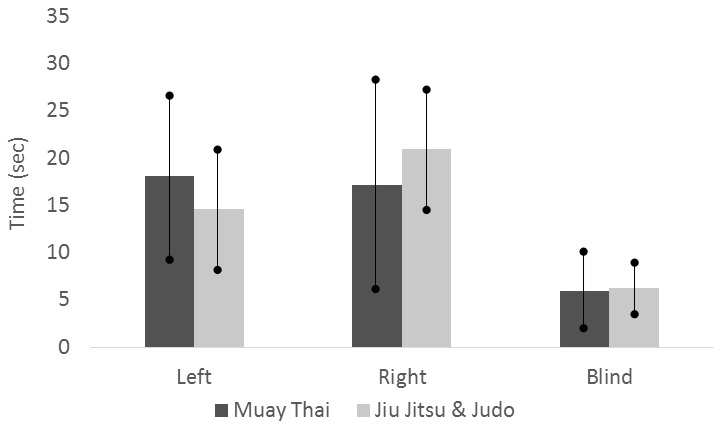
Figure 2 shows the results for the measures of flexibility. Flexion was 145.1±4.1 degrees (Jiu Jitsu/Judo) and 144±10.9 degrees (Muay Thai) resulting in a difference that was not significant (p=0.25). The measures for extension for Jiu Jitsu/ Judo (-2.2±3.9) and Muay Thai (-3.64±2.13 degrees) were also not significantly different (p=0.27). Internal hip rotation was 51.12±9.29 degrees (Jiu Jitsu/Judo and 54.28±11.04 degrees (Muay Thai) was also not significantly different (p=0.31). Finally, external hip rotation was 39±10.5 degrees for Jiu Jitsu/ Judo and 39.42±8.37 degrees for Muay Thai with a difference that was not significant (p=0.53).
Figure 2. Range of Motion in Degrees for Flexion, Extension, Internal and External Rotation that are the Average of both Legs
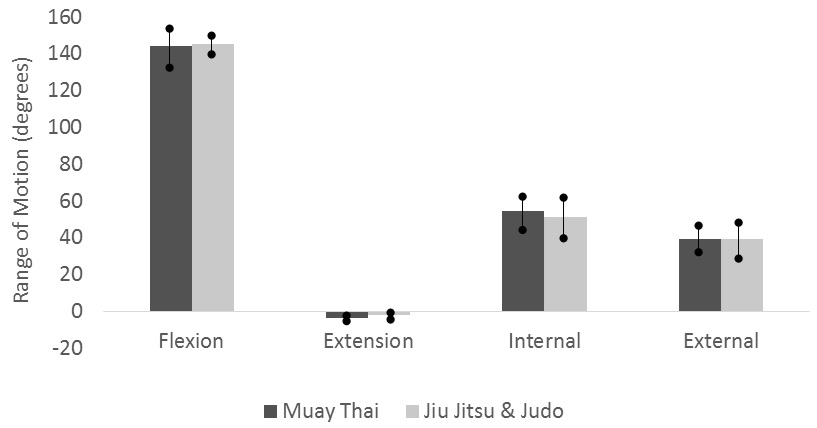
The results for the strength tests indicated a significant difference (p=0.043) between the two groups for right hand grip strength. Jiu Jitsu/Judo participants were stronger (56.3±11.3 lbs) than the Muay Thai participants (44.5±7.2 lbs). While the results for the left-hand grip strength of the Jiu Jitsu/Judo participants (54.8±8.1 lbs) were not significantly different from those who participated in Muay Thai (49.6±8.9 lbs), it did approach significance (p=0.056). All participants claimed to be right-hand dominant and these results are found in Figure 3.
Figure 3. Right and left grip strength measured in lbs (* indicates statistically significant
difference in right hand grip strength between the two groups, p<0.05).
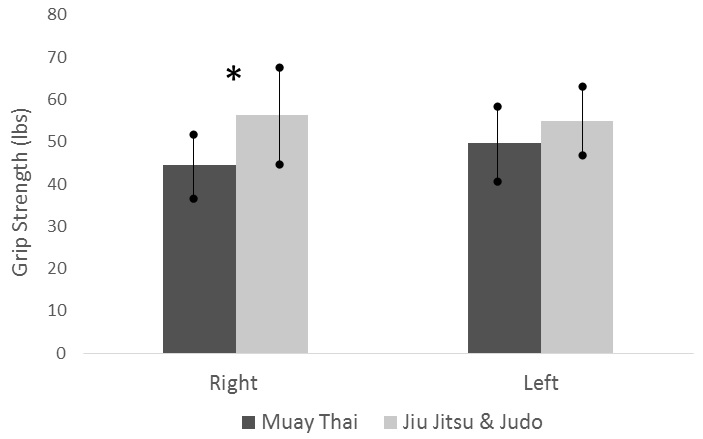
Leg strength was measured using a one-legged wall sit. Neither the right wall squat (Jiu Jitsu/Judo 47.4±11.3 sec; Muay Thai 44.5±7.3 sec) nor the left wall squat (Jiu Jitsu/Judo 53.2±27.7 sec; Muay Thai 45.4±20.7 sec) were significantly different (p=0.85 and p=0.30, respectively. These results are seen in Figure 4.
Figure 4. Right and Left Leg Wall Squat Reported as Time in Seconds
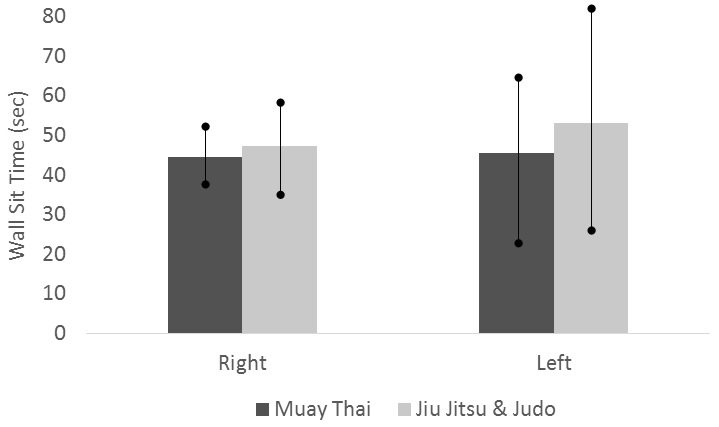
The significant difference (p=0.001) found in the T-test for agility indicated that those practicing Muay Thai (4.8±0.54 sec) were faster than those practicing Jiu Jitsu/Judo (7.71±1.38 sec). However, no significant difference (p=0.90) was found between Jiu Jitsu/Judo (15.68±1.1 sec) and Muay Thai (13.84±1.2 sec) for the hexagonal obstacle test and these results are noted in Figure 5.
Figure 5. T-test and Hexagonal Agility Tests (* indicates statistically significant difference in T-test, p<0.05)
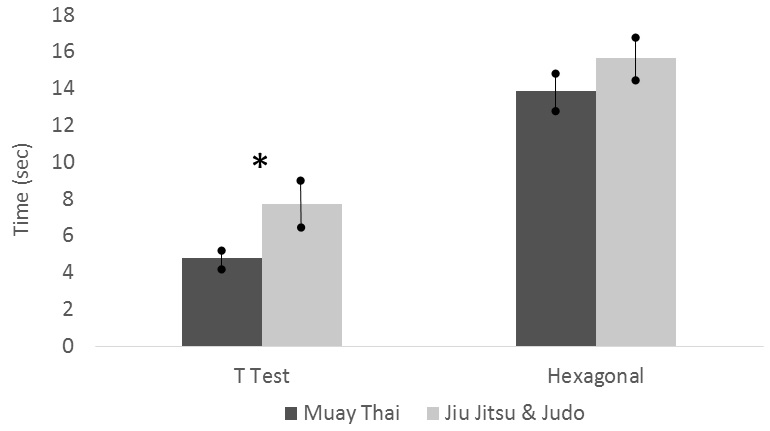
DISCUSSION
It was hypothesized that there would be significant differences between the two categories of martial arts based on the requirements of their respective training and competition. Although there were not significant differences in all categories between these two fighting styles, there were some significant differences found in the areas that distinguish their styles, namely, strength and agility. The significant differences between the two martial arts demonstrated that the agility of the Muay Thai participants, at least in the T-test, was significantly faster than that of the Jiu Jitsu/Judo participants (p=0.001, Figure 5). However, no significant differences were found in performance of the hexagonal agility test and can also be seen in Figure 5. This was probably due to the steep learning curve required to perform this test and one practice repetition may not have provided adequate time to learn this testing sequence. Further studies may want to give participants more detailed instructions and allow participants more time to practice prior to the recorded testing.
The Brazilian Jiu Jitsu/Judo group were determined to be significantly stronger for the right-hand grip measurement (p=0.043) but not for the left-hand grip measurement. However, this measurement approached significance (p=0.056). It was also observed that while 85.7% of Muay Thai subjects claimed to have right-hand dominance, all Muay Thai participants demonstrated left-hand dominance during the Grip Strength tests (Figure 3). This may be due to the practice of cross jabs in Muay Thai and the common practice of holding a stance that allows the competitor to face their opponent in a square setting, minimizing their opponent’s ability for open throws and kicks. This may be a contributor as to why right-hand dominance was found to be significant but left-hand dominance was not. Further research is needed to investigate this observation.
While Muay Thai has a heavy focus on body conditioning3 and has been specifically designed level of fitness promoting endurance needed for ring competition, Brazilian Jiu Jitsu appears to concentrates more on muscular strength increases as well as increase of muscle fiber recruitment rate over time with training due to its similarities with resistance training.10
Further research may want to extend the testing to include measurements of aerobic and anaerobic components. While the types of martial arts evaluated here appear to involve both the anaerobic and aerobic pathways, there do appear to be some differences. Brazilian Jiu Jitsu and Judo appear to have more of an aerobic component10,11 while those competing in Muay Thai rely more on anaerobic pathways.3 Recommendations for further research would also be to extend this study to the female population as well as the older population in order to determine the effects of these martial arts over a more extended period of time. The results of further research may provide training guidelines for Ultimate Fighting Championships and Mixed Martial Arts competitors.
CONCLUSION
Much attention has been given to mixed martial arts over the past 25 years and is a sport that incorporates the use of both striking and grappling, both standing and on the ground. Those competing in MMA draw from a variety of other combat sports and martial arts. The various martial arts have some overlap, however, taken individually, each martial art has unique physical demands requiring training focused on the techniques and expectations inherent within it. This was seen in our study in the significant differences in strength for those participating in Brazilian Jiu Jitsu/Judo versus those with greater speed and agility who participated in Muay Thai. The addition of females as participants as well as aerobic and anaerobic testing will greatly expand the knowledge of the physical demands of these sports.
ACKNOWLEDGMENTS
The authors wish to thank Jordan Shepler, a brown belt in Brazilian Jiu Jitsu, for his expertise in completing this manuscript.
AUTHORS CONTRIBUTIONS
Both authors have contributed to the data collection and writing of this manuscript.
CONFLICTS OF INTEREST
There are no conflicts of interest to disclose.
CONSENT STATEMENT
Participants’ Consent Statement was approved by the Institutional Review Board for the Protection of Human Subjects.










